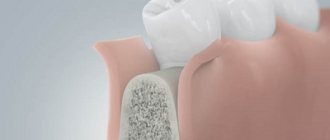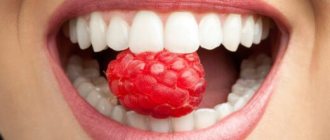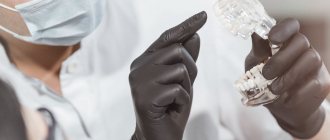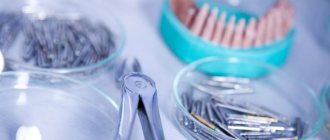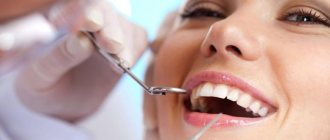Gum grafting or gingivoplasty is a surgical method of correcting, altering or restoring the gum contour to improve the appearance and structural condition of the gums.
In most cases, the operation does not require hospitalization and is performed as an outpatient visit to a doctor under local anesthesia quickly and painlessly.
| Gumplasty / Gingivoplasty | |
| Gumplasty of one tooth | 3,000 rub. |
| Consultation | for free |
Sign up for a consultation
Causes of gum abnormalities
Gingivitis, periodontitis, and periodontal disease are characterized by inflammation, hypertrophy or recession of gingival tissues, and the formation of periodontal pockets. In this case, the contours of the gum change; it either grows, covering the crown, or atrophies, exposing the roots. When periodontal pockets form with a large number of stones and granulomas, the edges of the mucous membranes become uneven.
Other causes of defect formation include congenital abnormalities, trauma during complex tooth extraction, and the formation of an uneven edge during implantation and prosthetics.
Laser gingivoplasty
This is a progressive method that minimally injures healthy tissue. When treating gums with a laser, the beam removes only necrotic, damaged areas and allows you to get rid of granulations. Tissue healing after such an intervention occurs faster, and the effect of the laser on the blood vessels avoids bleeding. In addition, the beam eliminates pathogenic microflora and does not cause swelling of soft tissues. After surgery, there is no need to stitch the mucosa.
The technology for performing the procedure is the same as for classical plastic surgery.
Indications for surgery
The main goal of gingivoplasty is to restore the aesthetics of the dentition. However, in the presence of diseases, surgery is performed to optimize treatment. For example, when the neck and root part are exposed, high sensitivity to cold and sour foods and loose teeth appear. Increasing gum tissue eliminates hyperesthesia and strengthens the dental unit.
Surgery is indicated in the following cases:
- uneven gingival margin;
- deep periodontal pockets;
- hypertrophy, overhanging the crown;
- recession (sinking) of the gums below the neck;
- inflammatory processes during teething.
Gum augmentation during implantation is carried out if there is a need to form an edge. It occurs when a lot of time has passed between tooth extraction and prosthetics. The gums atrophy and sag, so for aesthetics, prevention of peri-implantitis, and implant loss, the tissue is restored. If implantation is done immediately after removal, then this stage is skipped.
Types of gum plastic surgery
- gingivoplasty - restoration of gum volume during its atrophy, that is, recession, or implantation;
- gingivotomy - dissection of the wall of the periodontal pocket to perform open curettage;
- gingivectomy - cutting off part of the overgrown gum in the presence of large gum pockets.
Advantages and disadvantages
Like any surgical intervention, gingivoplasty radically solves complex problems, but can also cause complications.
The advantages of the procedure include:
- rapid elimination of large periodontal pockets;
- strengthening the tooth when the root is exposed and loose;
- returning the beauty of your smile;
- minimum contraindications;
- all manipulations take no more than 1 hour;
- no general anesthesia is required.
The disadvantages of the operation are a possible increase in mobility, increased sensitivity of the tooth, swelling, and pain. As a rule, complications are temporary and disappear within a few days. The patient is prescribed anesthetics to eliminate pain.
If the wound becomes infected, inflammation may develop with corresponding consequences. If swelling, redness and pain do not go away, but intensify, then you must urgently consult the doctor who performed the procedure.
Possible complications
Negative consequences after gum surgery rarely occur. The most common:
- Necrosis of flaps that were subjected to correction. Treatment consists of reducing the inflammatory process with antiseptic drugs. Revision gingivoplasty is also performed.
- Increased sensitivity of tooth enamel. Fluoridation and strengthening of enamel is recommended.
Possible reasons are medical errors, incorrect technique for performing the procedure, or the patient ignoring the doctor’s recommendations during the rehabilitation period.
Progress of the operation
To straighten the edge of the gum, the doctor makes incisions on the mucous membranes and separates the flap, that is, this is a flap operation. If there are periodontal pockets, then first a curettage is performed, during which tartar and granulomas are removed, antiseptic treatment is carried out, and bone tissue is replanted if necessary. After this, plastic surgery of the gum tissue is performed.
Procedure steps:
- treatment of mucous membranes with an antiseptic;
- anesthesia;
- incisions on the gums;
- detachment of a flap of tissue;
- pocket cleaning, root polishing, bone grafting (if indicated);
- correction of the shape of the flap and returning it to its place;
- suturing and bandaging.
Swelling occurs immediately after surgery. You will be able to see the result after the stitches have completely healed.
When using laser equipment, the likelihood of infection is practically absent. The treatment is carried out without pain, blood, and the rehabilitation period is much shorter. The application and subsequent removal of sutures is not required. Less swelling and pain.
How is gum grafting performed?
Depending on the patient's health condition and diagnosis, the course of the operation may vary significantly.
If the purpose of the intervention is to augment the gums/fill in a defect, gingivoplasty is performed. At the first stage, the surgeon prepares the place where the donor material will be transferred. Then a free gingival connective tissue graft is collected (most often the palate is the donor area). At the final stage, the donor flap is sutured to the recipient area using self-absorbing sutures. Gingivoplasty can be performed using the method of directed tissue regeneration, that is, by implanting an artificial membrane into the area of the recessive lesion. The method of moving a pedicle flap is also often practiced - the surgeon transplants areas of healthy mucosa with a submucosa located below the area of recession.
In case of incomplete tooth eruption, gingivotomy is performed - dissection of the gum in the area of the tooth crown, followed by curettage.
If there is excess mucous membrane, the surgeon performs gum surgery called gingivectomy. The surgeon excises excess mucosa and sutures the edges, fixing them in a new natural position, in which the mucosa tightly covers the necks of the teeth at the desired height.
Recovery period
To avoid complications and speed up the healing process, you must strictly follow the doctor’s instructions:
- stop smoking, as nicotine constricts blood vessels, which prevents tissue regeneration;
- include less sour and sweet foods in the diet, do not eat cold, hot, rough foods;
- brush your teeth with a soft brush with extreme caution (brushing is prohibited for the first 3 days);
- regularly rinse your mouth with antiseptics;
- exclude active physical activity and overheating of the body.
The rules must be followed for at least two weeks.
Features of postoperative care
After surgery, the patient must take daily oral care and take prescribed medications. Without a recommended course of treatment and lack of hygiene, inflammatory processes develop.
General recommendations:
- Carry out daily gentle brushing of your teeth with anti-inflammatory pastes at least twice a day - morning and evening;
- treat the oral cavity with antiseptics after each meal;
- apply lotions with healing gels to the gums (after consultation with the doctor);
- rinse your mouth with warm tinctures with medicinal herbs - sage, chamomile flowers, St. John's wort or oak bark.
In order for the healing process to proceed quickly, in addition to therapeutic measures, it is necessary to stop drinking alcoholic beverages and smoking for 2-3 weeks. If you are prone to bleeding, it is not recommended to exercise, go to the sauna or take hot baths during the recovery period. The foods consumed should be soft with a moderate amount of salt.
The Mitino Dental Center offers a large range of gum treatment procedures, including gingivoplasty. By contacting us, you will receive professional advice and safe treatment using modern equipment. Call us and specialists will make an appointment for you at any convenient time.
Cost of treatment
Our clinic performs gingivoplasty for any indication and level of complexity. The price is influenced by the area of the corrected area, the need to cleanse periodontal pockets and their depth, the method of anesthesia, and the drugs used. If it is necessary to build up the alveolar part of the bone and perform treatment under sedation, the price will be higher.
We employ doctors with extensive clinical experience. The clinic is equipped with modern equipment. We use only effective and safe drugs. Prices are agreed with the patient before the start of the procedures.
Contraindications
The procedure is effective and safe, but it is impossible to carry out if the patient:
- there are contraindications to anesthesia,
- respiratory disease - ARVI,
- increased body temperature,
- pathologies of an oncological nature,
- diabetes mellitus of any degree,
- allergy to anesthetic components,
- poor clotting and other blood diseases,
- bone diseases - arthritis, arthrosis.
Also, the operation is not performed for dental pathologies - caries, stomatitis and others. First, you will need to eliminate the diseases, and then gingivoplasty will be prescribed.
Gingivoplasty also includes surgery to remove excess tissue.
With the development of gingival hypertrophy, when the gum grows on the crown of the tooth and covers it, tissue excision techniques are used. For this purpose, microsurgical scalpels are used; they allow you to remove excess tissue very precisely, accurately and almost painlessly. However, the operation is always performed under local anesthesia, which creates comfort for the patient. After such manipulation, no stitches are required, the wound heals quickly, and the gums take on a healthy appearance.
All manipulations are performed under high magnification. The doctor uses a microscope or binoculars. This makes it possible to perform the work very accurately and achieve excellent results. In addition to equipment for modeling the gum contour, special microsurgical scalpels and ultra-thin threads are used, which are completely invisible in the healing area and do not create more trauma.
Prices for gingivoplasty in Moscow
The cost of the procedure in Moscow clinics varies from 1500-2500 rubles per tooth. The cost per segment is 4500-6000 rubles.
As mentioned earlier, gingivoplasty using a laser will be slightly more expensive than using the patchwork method, its price is from 3,000 to 4,000 rubles per tooth, on average 10,000 to 12,000 rubles per segment.
If you still have any questions about this method of gum correction or any other topics, feel free to contact the LeaderStom clinic, our highly qualified specialists will help you decide on treatment and return you to a healthy and Hollywood smile.


